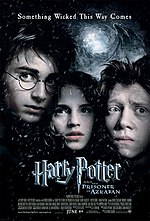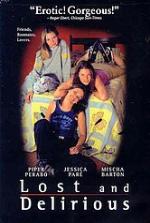

Knight at the Movies ARCHIVES

Schoolboy Fantasies:
Harry Potter 3 and Boarding School Movies
6-9-04 Knight at the Movies column
By Richard Knight, Jr.
As an unapologetic escapist when it comes to the movies (The Wizard of Oz is hands down my all time favorite),
I’ve eagerly followed up on any film that overtly brings daydreams to life for kiddies of all ages: the bizarre Dr.
Seuss based 5,000 Fingers of Mr. T, the enchanting Mary Poppins with Julie Andrews as the conceited but kindly
nanny, the sublime Willy Wonka & The Chocolate Factory that features Gene Wilder in the title role as the
schizophrenic sadist supreme. Even parts of The Never Ending Story and Ridley Scott’s Legend (the latter for
the breathtaking production design and certainly not the annoying performances of Mia Sarah, Tom Cruise and
Tim Curry) have their moments.
In 2001, fantasy became big business with the nearly dual release of Lord of the Rings: Fellowship of the Ring
and Harry Potter and the Sorcerer’s Stone, both intended to be long distance runners for their respective
studios. The first film in a series always has the edge and these two were no exception. Everything we’re shown
is new to us and in these movies had to literally be made up out of whole cloth. We go through these first
pictures getting our bearings, a little dumbstruck by all the visual panache.
H.P. 1 director Chris Columbus did a marvelous job at introducing us to the wizard shopping mall, Diagon Alley,
the razor toothed gnomes and their bank, and especially the magical mystery school, Hogwarts. Our first glimpse
of this fortress during a torch lit boat crossing was unforgettable, as were the attending sequences set in the
cavernous dining hall, the moving staircases and paintings, and later, the brightly colored Quidditch stands. But
once the thick as molasses plot kicked in, the pleasure of visual discovery dissipated and H.P. 1 dissolved into
routine Nancy Drew/Hardy Boy territory (albeit with incantations and magical wands).
I kept wanting to have another look at Hogwarts and its secrets rooms, which by now is almost as strong a
character as Harry, Ron and Hermione. H.P. 2, also helmed by Columbus, naturally, didn’t offer the pleasures of
discovery, but did feature a deepening of the characters (especially Harry’s) and again, a really involved story.
Plus, way too much of that white blonde snob Draco Malfoyle sneering (this time abetted by his father).
Now, H.P. 3 (official title is Harry Potter and the Prisoner of Azkaban) arrives with the competing
Rings trilogy finally out of the way. It may be the best of the Potter movies to date. A large reason for that is the
vision of director Alfonso Cuarón, perhaps best known for his sexy ménage a tois film, Y Tu Mamá. Fans of his
little seen masterpiece of fantasy, A Little Princess from 1995, could have expected that Cuarón would take the
H.P. reins with confidence not shown by his predecessor.
With or without author J.K. Rowling’s blessing, he’s had the good sense to toss out much of the book’s plot and
once again concentrate on mood. Less story and more feeling help the proceedings and guide our ghostly trio
safely through the rocky shoals of adolescence. Emma Thompson (who should do more comedies), villain’s
villain Gary Oldman chewing up every piece of scenery in his wake, and I’m sorry to say the snaggletoothed
David Thewlis (never less than completely annoying in every movie he’s made), are new additions on the block.
As is Michael Gambon, easily filling the shoes of Professor Dumbledore, vacated by the deceased Richard Harris.
The performances by the three teenage leads are in keeping with their previous work: earnest and a touch over
the top while the film as a whole is darker and more intense. More intense because this is a co-ed boarding
school after all and though it might seem a little predatory to even suggest that Ron might have had a
subconscious thought or two in the past about Harry, the poisonous behavior of Draco toward H.P. is starting to
seem a little, well, suspicious.
Movie-wise, boarding schools just seem to intensify adolescence. Certainly, Dead Poets Society, Cruel
Intentions, The Chocolate War, and Rushmore all offer proof that teenagers are society’s biggest drama
queens. Maybe, it’s all those hormones trapped day and night under one roof. Young Watson certainly seemed
impressed by more than the intellect of his new roommate in Young Sherlock Holmes and when Hayley Mills
discovered that she wanted to be a nun just like Rosalind Russell at the end of The Trouble With Angels it made
perfect sense to me why Hayley's best friend felt betrayed because, well, it was kind of implied that she was
going to end up with Hayley.
2001’s Lost and Delirious offers an explicit updating of the theme of two girls in love at boarding school and is a
sweetly poetic film that I hadn’t heard of until pointed in that direction by my editor, a fellow film fanatic.
“Teenagers,” the late singer-songwriter Laura Nyro once told me, “Are in touch with the primal forces of life”
and with Piper Parebo’s performance as the heartsick Dear Jane, we have literal proof of that statement. I’m
glad I’m not young anymore.
Harry Potter 3 and Boarding School Movies
6-9-04 Knight at the Movies column
By Richard Knight, Jr.
As an unapologetic escapist when it comes to the movies (The Wizard of Oz is hands down my all time favorite),
I’ve eagerly followed up on any film that overtly brings daydreams to life for kiddies of all ages: the bizarre Dr.
Seuss based 5,000 Fingers of Mr. T, the enchanting Mary Poppins with Julie Andrews as the conceited but kindly
nanny, the sublime Willy Wonka & The Chocolate Factory that features Gene Wilder in the title role as the
schizophrenic sadist supreme. Even parts of The Never Ending Story and Ridley Scott’s Legend (the latter for
the breathtaking production design and certainly not the annoying performances of Mia Sarah, Tom Cruise and
Tim Curry) have their moments.
In 2001, fantasy became big business with the nearly dual release of Lord of the Rings: Fellowship of the Ring
and Harry Potter and the Sorcerer’s Stone, both intended to be long distance runners for their respective
studios. The first film in a series always has the edge and these two were no exception. Everything we’re shown
is new to us and in these movies had to literally be made up out of whole cloth. We go through these first
pictures getting our bearings, a little dumbstruck by all the visual panache.
H.P. 1 director Chris Columbus did a marvelous job at introducing us to the wizard shopping mall, Diagon Alley,
the razor toothed gnomes and their bank, and especially the magical mystery school, Hogwarts. Our first glimpse
of this fortress during a torch lit boat crossing was unforgettable, as were the attending sequences set in the
cavernous dining hall, the moving staircases and paintings, and later, the brightly colored Quidditch stands. But
once the thick as molasses plot kicked in, the pleasure of visual discovery dissipated and H.P. 1 dissolved into
routine Nancy Drew/Hardy Boy territory (albeit with incantations and magical wands).
I kept wanting to have another look at Hogwarts and its secrets rooms, which by now is almost as strong a
character as Harry, Ron and Hermione. H.P. 2, also helmed by Columbus, naturally, didn’t offer the pleasures of
discovery, but did feature a deepening of the characters (especially Harry’s) and again, a really involved story.
Plus, way too much of that white blonde snob Draco Malfoyle sneering (this time abetted by his father).
Now, H.P. 3 (official title is Harry Potter and the Prisoner of Azkaban) arrives with the competing
Rings trilogy finally out of the way. It may be the best of the Potter movies to date. A large reason for that is the
vision of director Alfonso Cuarón, perhaps best known for his sexy ménage a tois film, Y Tu Mamá. Fans of his
little seen masterpiece of fantasy, A Little Princess from 1995, could have expected that Cuarón would take the
H.P. reins with confidence not shown by his predecessor.
With or without author J.K. Rowling’s blessing, he’s had the good sense to toss out much of the book’s plot and
once again concentrate on mood. Less story and more feeling help the proceedings and guide our ghostly trio
safely through the rocky shoals of adolescence. Emma Thompson (who should do more comedies), villain’s
villain Gary Oldman chewing up every piece of scenery in his wake, and I’m sorry to say the snaggletoothed
David Thewlis (never less than completely annoying in every movie he’s made), are new additions on the block.
As is Michael Gambon, easily filling the shoes of Professor Dumbledore, vacated by the deceased Richard Harris.
The performances by the three teenage leads are in keeping with their previous work: earnest and a touch over
the top while the film as a whole is darker and more intense. More intense because this is a co-ed boarding
school after all and though it might seem a little predatory to even suggest that Ron might have had a
subconscious thought or two in the past about Harry, the poisonous behavior of Draco toward H.P. is starting to
seem a little, well, suspicious.
Movie-wise, boarding schools just seem to intensify adolescence. Certainly, Dead Poets Society, Cruel
Intentions, The Chocolate War, and Rushmore all offer proof that teenagers are society’s biggest drama
queens. Maybe, it’s all those hormones trapped day and night under one roof. Young Watson certainly seemed
impressed by more than the intellect of his new roommate in Young Sherlock Holmes and when Hayley Mills
discovered that she wanted to be a nun just like Rosalind Russell at the end of The Trouble With Angels it made
perfect sense to me why Hayley's best friend felt betrayed because, well, it was kind of implied that she was
going to end up with Hayley.
2001’s Lost and Delirious offers an explicit updating of the theme of two girls in love at boarding school and is a
sweetly poetic film that I hadn’t heard of until pointed in that direction by my editor, a fellow film fanatic.
“Teenagers,” the late singer-songwriter Laura Nyro once told me, “Are in touch with the primal forces of life”
and with Piper Parebo’s performance as the heartsick Dear Jane, we have literal proof of that statement. I’m
glad I’m not young anymore.
Something fantastic this way comes -- and something horny, too

